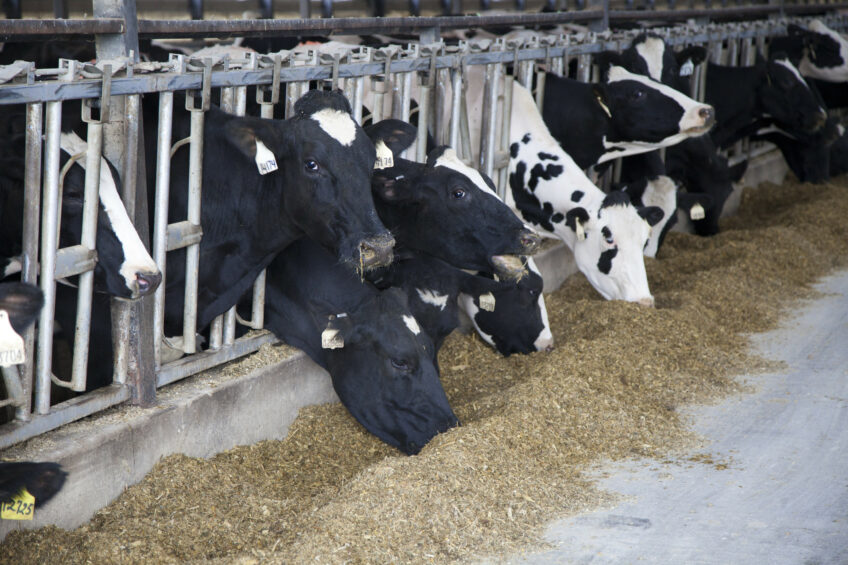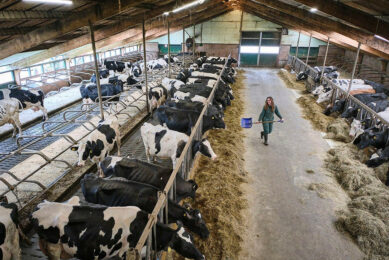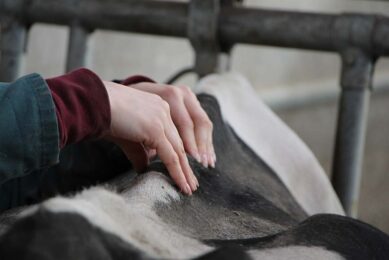Does feed efficiency mean financial efficiency?

Dairy farmers face a range of challenges. To maintain a profitable farm, dairy producers need to examine their feed management and nutritional applications to sustain profitability.
Lately, dairy farmers are often being advised that the best remedy for the current economic climate is to look more closely at production costs and increase the efficiency with which they use their feeds. Higher input costs and falling milk prices, combined with existing challenges, negatively affect the profitability of any dairy enterprise. As feed prices currently represent around 60% of the total cost of milk production, dairy farmers need to ensure that feed efficiency monitoring is included as a key parameter in their management strategy. But is higher feed efficiency always a good thing? In dairy cows, feed efficiency refers to the kilograms of milk produced per kilograms of dry matter consumed. In simpler terms, how efficiently dairy cows can convert consumed nutrients into products, such as milk, muscle, fat and calves. Following the adage “more is better,” many producers have simply focused on maximising their cows’ dry matter intake (DMI) and hoped for the best, in terms of efficiency.

Importance of feed efficiency
Although there are many factors affecting feed efficiency, including the stage of lactation, digestibility of the diet and the genetic potential of the animal in question, the accuracy of the figures used to calculate it can also impact on the final value and can, in some cases, render the calculated value worthless (Hall, 2003). Measuring herd average Feed Conversion Efficiency (FCE) over time reflects trends in performance and can be linked to feed and milk price to reflect margin over total feed consumed.
For the most part, the key to feed efficiency rests with rumen function, as sub-optimal functioning will not allow maximum digestion of the feed offered. The success of a dairy system is somewhat predicated on active engagement, including attempts to “see” the cows. Using monitors and measures to assess nutritional management effects on cow health and production performance, on a daily, weekly and monthly basis, is also critical. Today, financial efficiency really counts, meaning, as concentrate (corn and soy) prices increase, we should make the most of cheaper high-fibre feeds, especially forages. These attempts at better feed efficiency should be integrated into a feeding strategy. Subsequently, the beneficial impact of increased feed efficiency on production can be taken into account. The efficient use of feeds should always be the goal, and this can be achieved by looking at forage quality, rumen health and nutritional applications.
Forage quality
Plan to make the highest quality forage possible, since it is a large component of the slowly digestible part of the diet of lactating cows. Forage is the most variable feed ingredient, in terms of digestibility and nutrient composition, and it comprises a greater proportion of the rations than any other feedstuff. High-quality forage is more digestible, so you will be able to feed more of it to cows. Rumen health and productivity will be improved with the use of high quality forages and, as such, forages can influence feed efficiency through the maintenance of a desirable rumen environment. Acidosis (low rumen pH) can negatively affect feed efficiency by decreasing fibre digestibility through changes in the rumen microbial profiles. Including adequate physically effective fibre (forage particle size) in the rations will help maintain the proper rumen environment by stimulating chewing and rumination, increasing saliva secretion and improving buffering capacity of the rumen. Proper forage particle length is also needed to maintain the rumen environment and proper rumen motility.
Read also: Munch, munch: Cow chewing unravelled
Rumen health
There are several elements of increasing feed efficiency, but one of the most important is to maximise rumen function by supporting the activity and growth of the rumen microflora, enabling dietary nutrients to be extracted from the diet as efficiently as possible. The nutrients provided to the rumen microflora need to be well-balanced in terms of fermentable energy and protein (nitrogen) supply. Fermentable protein nutrition must be specifically adapted to maximise rumen microbial population activity and growth, as different populations have different requirements in terms of how nitrogen is supplied. For instance, cellulolytic bacteria have optimal activity and growth when nitrogen is supplied as non-protein nitrogen or ammonia, while amylolytic bacteria require short peptides and amino-acids. However, milk production isn’t simply connected to rumen degradable protein supply, as digestible protein supply to the intestine is also a function. Thus, the quantity and quality of these digestible proteins are of great importance.
Nutritional applications
For years, dairy nutritionists have overfed crude protein in an attempt to meet amino acid requirements for the desired milk yield. Besides the significant increase in input costs, this also results in poor nitrogen efficiency and, subsequently, higher nitrogen excretion, which is detrimental to the environment. The dairy cow inherently suffers from this poor nitrogen efficiency, since excessive nitrogen is converted first into ammonia and then into urea, which is partially recycled, but the vast majority is excreted. Ultimately, there is an energy loss associated with this process, due to the detoxification of ammonia into urea. This energy cost comes at the expense of milk production and other biological functions, such as reproductive performance. The energy required to excrete excess nitrogen is equivalent to up to 2kg of milk and can lead to body condition loss, increased blood and milk urea levels and, subsequently, issues with reproductive performance. In a recent literary review, Normand St-Pierre and Mike Van de Haar described the rumen’s utilisation of dietary protein as only 30% efficient. That means that only 30% of the nitrogen fed to cows ends up as tissue or in milk protein; the remainder is excreted.
Examine feed management
Microbial protein is best suited to meet the cow’s amino acid requirements, allowing her to make milk, develop a foetus and generate milk protein more efficiently. Studies have shown that rumen bugs’ nitrogen requirements can be more consistently met when fed a source of controlled-release nitrogen, which can also help the cow more precisely meet her amino acid requirements. It can also assist with nitrogen utilisation, converting more of the feed she eats into microbial protein and allowing the cow to transfer more nitrogen into the growth of tissue or foetus or to make milk protein, instead of excreting the nitrogen on the ground. With the current economy, dairy producers need to examine their feed management and nutritional applications to sustain profitability. By using good quality forage, supporting rumen health and using a tailored ration formulation, producers can cut back on losses and keep their productions running more efficiently, thus resulting in potential cost savings.
Join 13,000+ subscribers
Subscribe to our newsletter to stay updated about all the need-to-know content in the dairy sector, two times a week.










